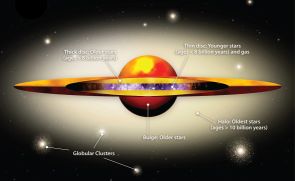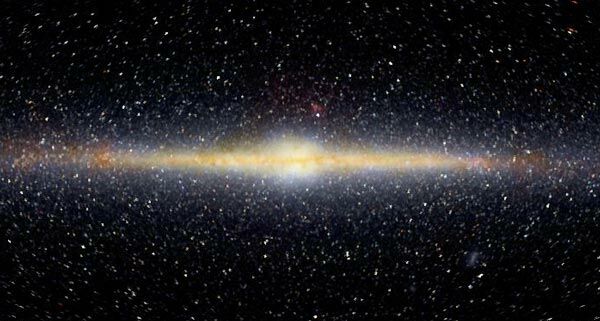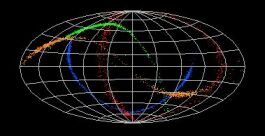Milky Way's Luminous Halo

Milky Way's Luminous Halo |

|
|
| Home | X-Objects | Stars | Habitability | Life | |
 Masashi Chiba,
Masashi Chiba,
Tohoku University,
SDSS-II
Larger illustration.
The Milky Way's spiral disk is
surrounded by a luminous halo
of older Population II stars and
stellar remnants, which recently
has been found to be composed
of two nested components rotating
in opposing directions
(more).
The Luminous Halo
 Robert Gendler,
Amanda Smith,
IoA,
Cambridge U.
Robert Gendler,
Amanda Smith,
IoA,
Cambridge U.
Larger and
jumbo image.
Spiral galaxies like the Milky Way and its largest neighbor,
Andromeda, have large central bulges of mostly older stars,
as well as a relatively young thin spiral disk (surrounded
by older, thick disk stars that may have come from mergers
with satellite galaxies) and a
luminous halo that includes
numerous globular clusters
(more).
The Milky Way's spiral disk of stars, gas, and dust is mixed into and surrounded by a luminous halo of mostly ancient "Population II" stars and stellar remnants (e.g., white dwarfs) in independent motion and as part of globular clusters and satellite galaxies that were captured gravitationally and are being shredded and absorbed into the galactic halo. In turn, this luminous halo of visible "normal" or ordinary matter is mixed into and surrounded by an overlapping, larger halo of some nonluminous ordinary matter of mostly gas and dust and much more dark matter. Most halo stars are thought to have been born in an earlier age than disk stars, when hydrogen and helium gas was less "polluted" by heavier elements ("metals") from stellar winds and supernovae of the most massive stars. Hence, halo stars are composed typically of only 0.1 percent metals, relatively "metal poor" compared to the "Population I" stars of the spiral disk. However, analysis of the galaxy's distribution of RR Lyrae populations and concentrations suggest that the oldest stars may have been polluted with heavy elements earliest by the first stars (Population III) which were more likely to have been located or incorporated early into the galaxy's central bulge, as more massive galaxies like the Milky Way and Andromeda probably formed earlier than smaller satellite galaxies now being incorporated into them (Tim Folger, Discover, May 1, 1993; Ken Croswell, New Scientist, September 19, 1992; and Young-Wook Lee, 1992). (More discussion of stellar populations.)
 WMAP,
GSFC,
NASA
WMAP,
GSFC,
NASA
Larger illustration.
The cosmos appears to be comprised
of very little ordinary matter made of
atoms (around four percent), that form
the stars, planets, and clouds of gas
and dust found in the halo as well as
in the spiral disk and central bulge
(latest WMAP
results).
On December 12, 2007, astronomers using the Sloan Digital Sky Survey (SDSS) announced that observation and analysis of the stellar motion and spectra of 20,000 stars in the luminous halo indicated that the luminous halo is composed a mix of two distinct components rotating in opposite directions (SDSS news release; Texas Tech University press release; and Carolo et al, 2007). While stars in the Milky Way's spiral disk orbiting around the the galactic center at some 500,000 miles or 805,000 kilometers (km) per hour. The inner halo, located well outside the disk, rotates in the same direction, but at a much sedate 50,000 miles (80,500 km) per hour -- of one-tenth of the disk's speed, while the outer halo spins twice as fast as the inner halo in the opposite direction at about 100,000 miles (161,000 km) per hour. In addition to differences in stellar motions, the two halo components also display relative differences in elemental composition which indicate were probably formed in different ways at different times.

Edward
L. Wright,
COBE,
DIRBE,
NASA -- larger infrared image
(In their motions around the galactic center, both inner- and
outer-halo stars may pass through the spiral disk,
sometimes in the vicinity of the Sun --
more.)
Inner Stellar Halo
The inner halo is somewhat more flattened in shape. It dominates the population of stars up to 50,000 light-years from the galactic center. These stars are relatively more metals rich than outer-halo stars, with around three times more heavy atoms such as iron and calcium. These heavier elements were forged in early forming stars and ejected into surrounding space by supernovae or in stellar winds. Its discoverers believe that it formed before the outer halo from the collision of smaller but massive galaxies that rotated with the Galaxy. Past research suggests that there have been no major accretion events in the inner halo over the last few billion years (Brown el al, 2003).
 © Kathryn
V. Johnston, Chris Mihos,
© Kathryn
V. Johnston, Chris Mihos,
Van Kleck Observatory/Wesleyan University
(Used with permission)
Larger illustration.
"Fossil" remnants of satellite galaxies that have
collided with the Milky Way may be observed as
star streams (more
discussion
and
simulations).
Outer Stellar Halo
The outer halo is more spherical in shape than the inner halo. It dominates the stellar population beyond 65,000 light-years from the galactic center and may extend out to more than 300,000 light-years. This outer halo is believed to have formed later than the inner one from small galaxies orbiting the Milky Way in the reverse direction, which did not share the chemical history of the Milky Way Galaxy.. These galaxies and their globular clusters were eventually torn apart by the Milky Way's gravitational forces which dispersed their stars into the halo (I.I. Ivans, 2006). Past research has suggested that the Milky Way is embedded in an extended, highly inclined, triaxialhao defined by the spatial distribution of its companion galaxies (